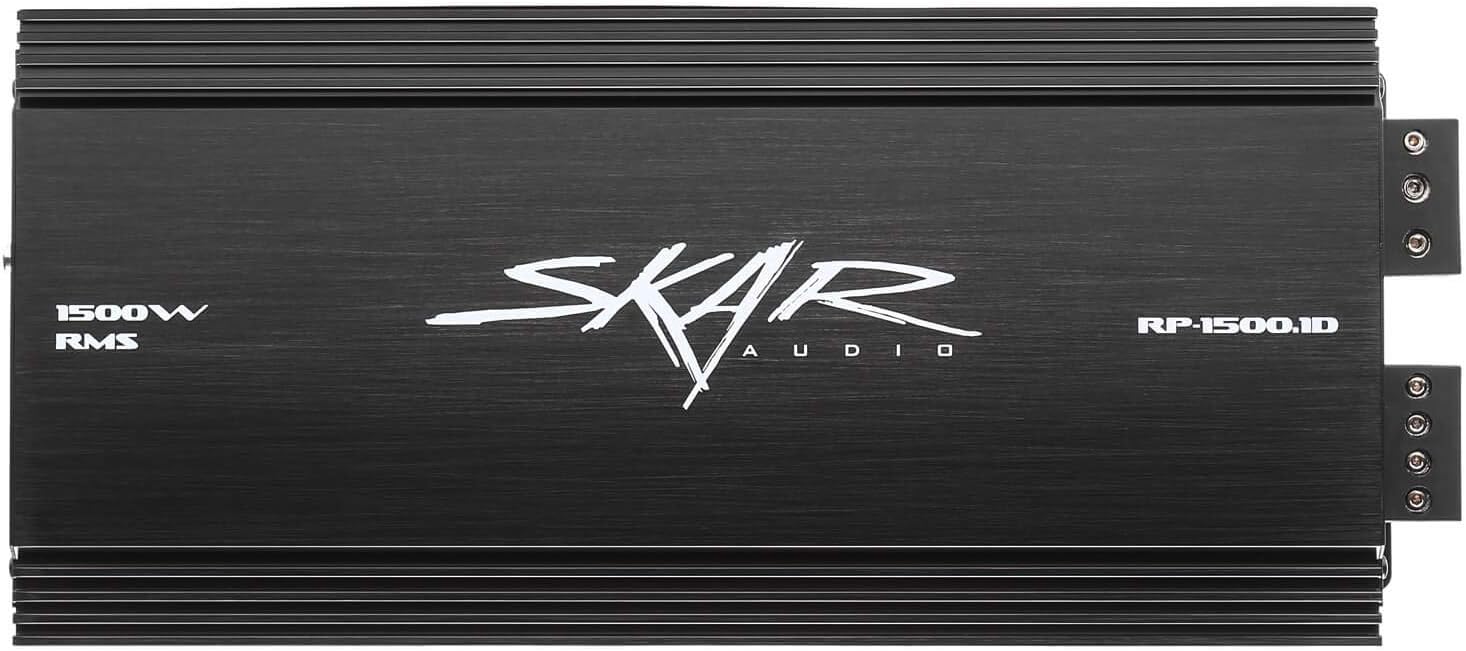If you want reliable, wallet-friendly bass power for a 1-ohm sub setup, the Skar Audio RP-1500.1D is the amp everyone keeps recommending — and for good reason. In this detailed review, we put it in context for real-world daily use, from electrical needs to tuning for clean output. For background, see our guides on amplifier wattage and impedance matching.
Affiliate Disclosure: AmplifierZone is reader-supported. As an Amazon Associate, we may earn commissions from qualifying purchases at no extra cost to you.

In this review
Skar Audio RP-1500.1D — Overview & Sound
The Skar Audio RP-1500.1D is a Class D monoblock built for 1-ohm stability and hard-hitting daily bass. In practice, it pairs well with popular 12″ and 15″ subs that can genuinely use 1,200–1,500 W RMS at 1 Ω. Expect punchy low-end with enough headroom for modern bass music — provided your electrical and gains are set correctly.

Skar keeps things straightforward: compact chassis, simple controls, subsonic + low-pass filters, and a bass remote for quick level trims. Thermal performance is decent for the price tier; give it breathing room and avoid burying it under trunk liners. In long sessions, it stays manageable so long as you’re not clipping into low voltage.
On the install side, budget for a proper 4-gauge OFC wiring kit (or better), clean grounds, and proper gain overlap. That combination separates clean, heavy bass from the muddy distortion many users blame on the amp. If your car’s voltage sags, consider a Big 3 upgrade first; if heat persists, see our tips to fix amplifier overheating.
Who is it for?
Drivers who want affordable, hard-hitting bass with a 1-ohm stable mono amp, are willing to install a proper wiring kit, and will set gains correctly. If you’re chasing ultra-low noise floors and boutique SQ, look elsewhere; if you want value bass power, this belongs on your shortlist.
Buying considerations before choosing the RP-1500.1D
- Electrical headroom: Expect real current draw at 1 Ω. Big 3 + healthy battery recommended.
- Wiring: True OFC copper, clean ground, correct fuse sizing are non-negotiable.
- Gain setup: Use test tones and avoid clipping; the bass remote is not a gain knob.
- Sub match: Aim for subs that can comfortably take 1,200–1,500 W RMS @ 1 Ω.
Pros & Cons
- Pros: Solid 1-ohm performance; simple controls with subsonic/LPF & bass remote; compact for the power class.
- Cons: Will expose weak electrical systems (dimming, heat); not an SQ champ; runs warm in tight installs.
Where to buy
Competitor alternatives
If you’re comparing the RP-1500.1D with similar 1-ohm Class D mono amps in the same price and power range, these models are often cross-shopped by bass enthusiasts:
- CT Sounds AT-1400.1D – similar RMS output with a cleaner signal path, popular with SQ-leaning builds.
- Rockville Krypton K1 – cheaper alternative, still 1-ohm stable, but runs hotter under load.
- Skar Audio RP-2000.1D – same lineup, a step up in wattage if you plan to upgrade subs later.
(We’ll expand this into a full comparison once individual reviews for each model are published.)
Final verdict
If you need serious bass on a budget and can support a 1-ohm mono with proper wiring and gains, the Skar Audio RP-1500.1D delivers. It’s not the quietest, nor the coolest-running amp in the world, but for daily use and weekend flexing, it hits well above its price.
FAQs
Is the RP-1500.1D really 1-ohm stable for daily use?
Yes — with adequate wiring, airflow, and proper gain setup.
Do I need to upgrade my battery or alternator?
Start with Big 3 wiring and a healthy battery; upgrade the alternator only if voltage still dips.
Why does my amp get hot?
Restricted airflow and low voltage are common culprits. Ensure ventilation and sufficient wire gauge.
Can I run it at 2 ohms for cleaner sound?
Yes; 2 Ω typically runs cooler and cleaner but with less output.
Quick How-To: Basic gain setup (RP-1500.1D)
- Set head unit to ~75% volume; EQ flat.
- On amp: gain fully down; subsonic just below box tune; LPF ~80 Hz.
- Play a 40 Hz test tone; slowly raise gain until near distortion; back off slightly.
- Use the bass remote for small trims; re-check after a few tracks.
Amazon Affiliate Disclosure: As an Amazon Associate, AmplifierZone earns from qualifying purchases. This does not affect our opinions or product selections.
